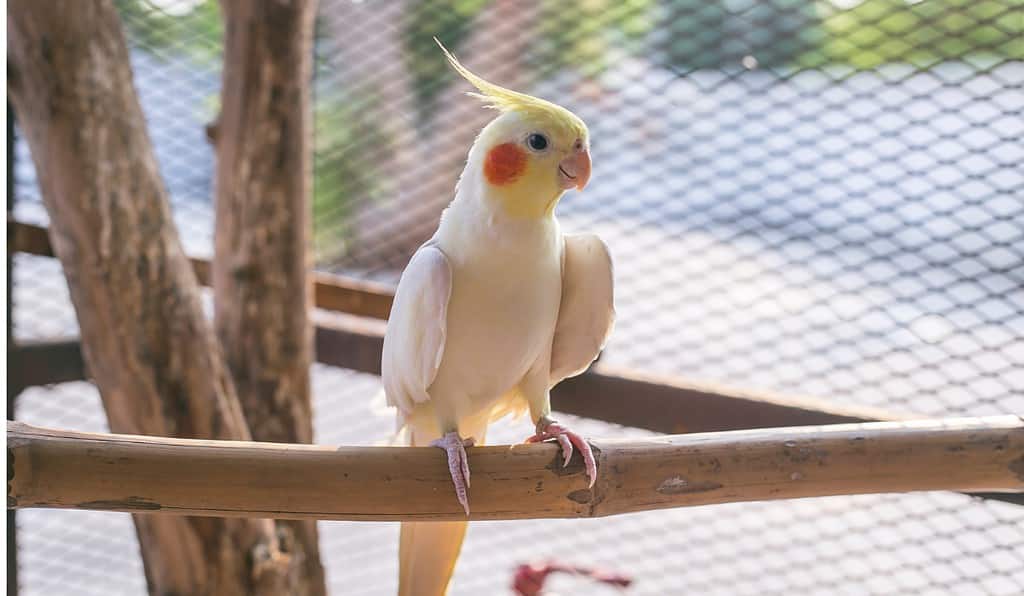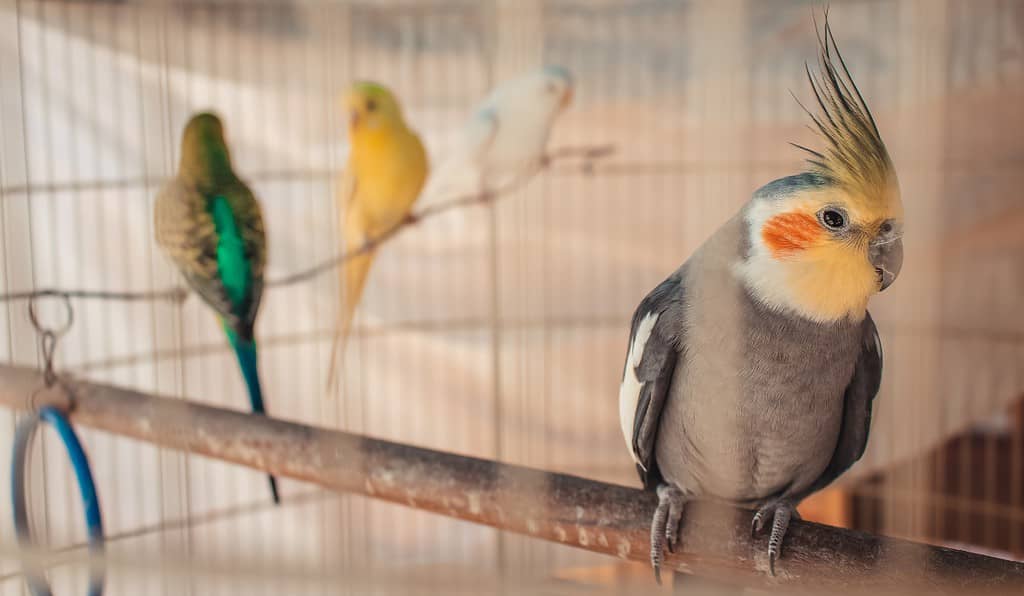
Every cockatiel owner knows that these vibrant and lively birds, with their distinctive crests and playful nature, deserve the best care. Yet, many might be surprised to learn that the size of their cage plays a pivotal role in their overall well-being. A cramped space can lead to stress, obesity, and even behavioral issues, while a spacious environment can make them chirpier and more lively.
As a general rule, the ideal cage size for a single cockatiel should be a minimum of 24x24x24 inches, ensuring they have ample space for movement, toys, and perches. For pairs or special needs like breeding, the dimensions vary, but the underlying principle remains: bigger is usually better.
Ready to dive deeper into the world of cockatiel habitats? Let’s explore the nuances of cage sizes, materials, and other essentials to ensure your feathered friend lives a happy, healthy life.
Understanding the Importance of Cage Size
As we delve deeper into the world of cockatiels and their habitats, it’s essential to grasp the nuances of cage sizes and their implications.
Why Size Matters
Imagine being confined to a small room where you can barely stretch your arms, let alone walk around. That’s how a cockatiel feels in a cramped cage. Providing ample space is essential for their movement and flight, ensuring they remain active and healthy. Moreover, the size of the cage directly correlates with a bird’s well-being. A spacious environment reduces stress, prevents obesity, and promotes natural behaviors, making your feathered friend chirpier and more lively.
Recommended Sizes for Different Needs
| Need | Dimensions (W x L x H) | Special Considerations |
| Single cockatiel | Minimum 24x24x24 inches | Ensure enough space for toys and perches. Metal cages that are powder coated with non-toxic material are best. |
| Pair of cockatiels | At least 24x24x36 inches | Ample space for both birds to move freely. Metal cages are preferable as cockatiels tend to chew on things. |
| Flight cages | 48 inches wide, 144 inches long, and 96 inches high. | Designed for free flight and exercise. Wider cages are preferable as cockatiels fly side to side. |
| Travel cages | 12 inches wide and high | Temporary; ensure it’s secure and well-ventilated. |
| Breeding cages | 20 x 20 x 50 inches | Must accommodate nesting and chick-rearing. Cockatiels only need nesting material if they are a breeding pair. |
Note: The dimensions provided are based on my experience. Always consider your bird’s individual needs and consult with a vet or bird specialist when in doubt.
Cage Setup Essentials
Every bird enthusiast knows that setting up a cage goes beyond just dimensions. It’s about creating a comfortable, stimulating, and safe environment for your feathered friend.
Placement
The location of your cockatiel’s cage plays a pivotal role in their overall well-being. It’s crucial to place the cage in a well-ventilated location, ensuring that it’s away from drafts and direct sunlight. These factors can cause discomfort and even health issues for your bird. Additionally, placing the cage at eye level promotes better socialization. It allows your cockatiel to feel like a part of the family, observing and interacting with the daily happenings of the household.
Perches
Perches aren’t just resting spots for your bird; they play a significant role in their foot health. Offering a variety of perches with different diameters ensures that your cockatiel exercises its feet, preventing potential health issues.
Natural perches: These are often branches or wooden pieces that mimic the bird’s natural environment. They are excellent for foot exercise and come in varying diameters.
Benefits:
- Mimics natural environment.
- Provides varying diameters for foot exercise.
- Often has a rough texture, which is good for nail health.
Artificial perches: Made from materials like plastic or rubber. While they can be easier to clean, they might not offer the same benefits as natural ones.
Benefits:
- Easy to clean and maintain.
- Can be more durable than natural perches.
- Available in various colors and designs to match cage aesthetics.
Food and Water Arrangements
Your cockatiel’s health is directly influenced by its diet. Here’s how to ensure proper food and water arrangement in the cage:
- Placement: Position food and water bowls at a height that’s easily accessible to your bird, but away from perches to prevent contamination.
- Quality: Always provide fresh water and high-quality bird food. Remember, a balanced diet ensures a happy and healthy cockatiel.
- Cleaning: Clean the bowls daily to prevent bacterial growth. Stale food and dirty water can lead to diseases.
- Variety: Occasionally introduce fruits and vegetables to provide essential nutrients.
- Observation: Monitor your bird’s eating habits. Any sudden change can be an indicator of health issues.
Toys and Entertainment
A stimulated bird is a happy bird. Toys play a crucial role in providing mental stimulation and preventing boredom.
- Chewable toys: Made of safe materials that birds can nibble on. Helps in beak maintenance.
- Interactive toys: These toys require the bird to solve a puzzle or perform an action to get a reward, often a treat.
- Bells and rattles: Birds love sounds. These toys can keep them entertained for hours.
- Mirrors: While some birds enjoy the company of their reflection, be cautious as some cockatiels might mistake their reflection as another bird and become aggressive.
Cage Maintenance and Cleaning
A clean cage is paramount for your bird’s health. Regular maintenance ensures that your cockatiel is free from diseases and feels comfortable in its environment.
- Daily cleaning: Remove any uneaten food, droppings, and replace the cage lining daily.
- Weekly deep cleaning: Once a week, take out all the toys, perches, and bowls for a thorough cleaning. Use warm water and a mild detergent.
- Monthly disinfection: At least once a month, disinfect the entire cage using a bird-safe disinfectant.
- Toys and perches: Clean them regularly and check for any signs of wear and tear. Damaged toys can harm your bird.
- Avoid strong chemicals: Always opt for antibacterial bird sprays that are non-toxic for them.
Remember, your bird’s cage is its home. It’s where they retire at night, feeling safe and secure. Regular maintenance ensures that this sanctuary remains pristine, ensuring the happiness and health of your beloved cockatiel.
Other Important Considerations

As we continue our journey into the world of cockatiels, there are a few more essential factors to consider. These elements, while sometimes overlooked, play a crucial role in ensuring the safety, comfort, and longevity of your bird’s habitat.
Bar Spacing
The spacing between the bars of a cage is more than just an aesthetic choice; it’s a safety measure. The right spacing ensures that your cockatiel doesn’t get injured or find an escape route.
| Aspect | Horizontal Bars | Vertical Bars |
| Safety | Less chance of head getting trapped | Higher risk of injury |
| Climbing | Easier for cockatiels to climb | Can be challenging for climbing |
| Visibility | Better visibility for the bird | Slightly obstructed view |
| Cleaning | Easier to clean | Might require more effort |
Material and Durability
The material of the cage is paramount not just for durability but also for the safety of your cockatiel.
- Stainless Steel: Resistant to rust, easy to clean, and highly durable.
- Iron: Durable but requires a protective coating to prevent rust.
- Aluminum: Lightweight and rust-resistant but might be less sturdy than steel.
- Avoid certain plastics: Some plastics can be harmful if ingested, so always ensure the cage materials are bird-safe.
Safety and Security
Cockatiels are intelligent creatures, and their inquisitive nature can sometimes lead them to explore ways to open their cages. Here’s how to ensure their security:
- Sturdy Locks: Always opt for cages with reliable locking mechanisms.
- Double Latches: These provide an added layer of security.
- Regular Checks: Periodically inspect the cage for any wear or damage that might offer an escape route.
- Positioning: Place the cage in an area free from potential hazards like other pets or open windows.
Conclusion
Choosing the right cage for your cockatiel is a labor of love. It’s about ensuring their safety, comfort, and happiness. Over the years, I’ve seen the difference the right environment can make in a bird’s demeanor and health. It’s a testament to the bond between a pet and its owner. So, as you embark on this journey, remember that every choice you make is a step towards a happier, chirpier companion. I’d love to hear your thoughts and experiences, so please share them in the comments below and spread the word if you found this guide helpful!
